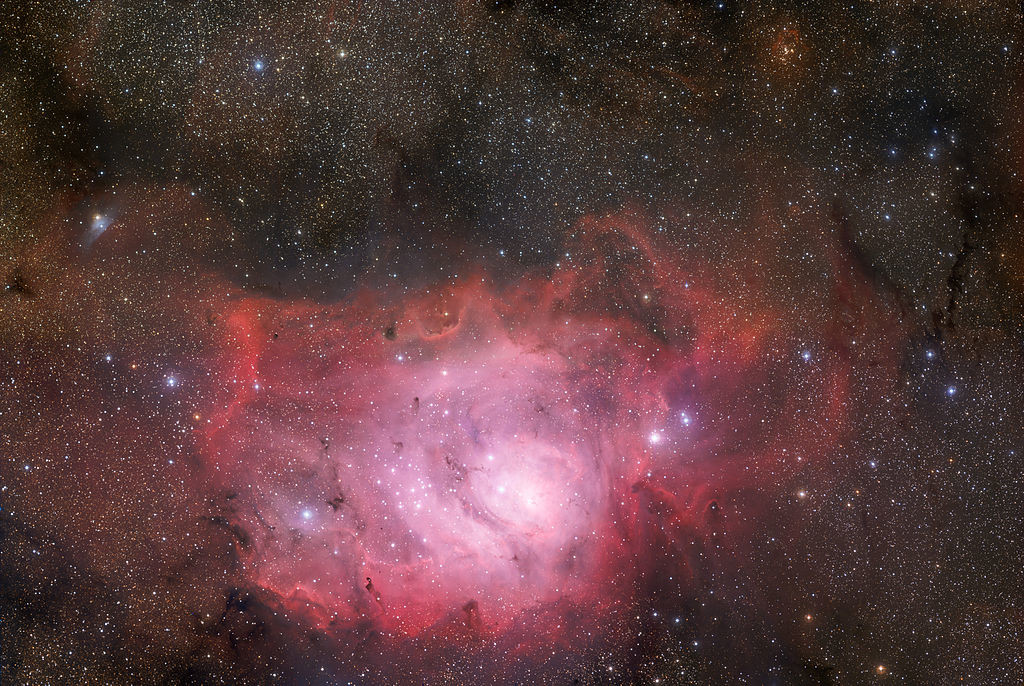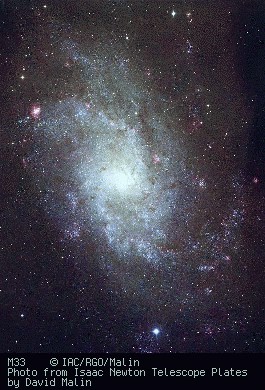



| Observer: | Tom Campbell |
| Location: | Iola, Kansas (Long: 95 30' W Lat: 37 55' N) |
| Equipment: | 8" Discovery DHQ dob |
| Eyepieces: | 1.25" Plössls (25mm, 15mm, 10mm, 6.5mm, 4mm) |
| Filters: | Lumicon O-III |
| Time: | 9:15pm - 12:15am CDT |
| Transparency: | 9/10 |
| Seeing: | 8/10 |
| Weather: | Temperature in the 70s. There was a slight breeze. |

This past week, I received an email from my observing buddy Mike. He stated that he'd been driving around the countryside and found a nice and dark piece of sky. He'd gotten permission from a farmer in the area for either of us to use his pasture anytime we wished. I was excited about this, and couldn't wait to see exactly how dark it was.
Tonight, everything fell into place. There was a New Moon, it was a weekend, and the sky was absolutely cloudless (except for a bank of far-off clouds on the low Southern horizon). Combine that with a dark site, and it would be absolute bliss!
Mike and I met up with each other about 7:45p and took off for darker skies. Upon first arriving at the site, I was dismayed at the number of trees along the sides of the pasture. The east side had a small creek running through it, which of course meant a lot of trees along the banks. However, as we drove deeper into the pasture, a large clearing presented itself and the trees didn't block more than about 10 degrees of sky in any direction.
As the sun disappeared in the west, one of the best features of the site became more obvious. No lighting of any kind was visible. The small light domes of nearby rural towns were easily obscured by the wall of trees surrounding the pasture. The visible sky was only slightly brightened by these distant lights.
When twilight neared an end, things really started to get exciting. I had never seen the Milky Way so bright! The dome of the core of our galaxy was easily visible through Ophiuchus and along the back of Scorpius. The Great Rift was incredible, and many small dark tendrils could be seen. While I don't claim that the Milky Way could cast a shadow at a dark enough site, I no longer consider it outside the realm of possibility. I even found myself slightly annoyed at Mars being so bright, as I'm sure its glare was reducing some of the glory of the Southern Milky Way behind it.
I must've just stared at the skies for several minutes, my jaw hanging open like a Venus Flytrap. Luckily, I had donned my insect repellant, or my simile might've turned literal. Finally, I remembered that I had a telescope set up nearby, and quickly turned it south. First up on my list were a couple of DSOs in the lower part of Scorpius that were too low for viewing at home.
| Table of Scorpius | Scorpius | Open Cluster | 9:20pm CDT |
| NGC 6231 | RA: 16 54.0 | Dec: -41 48 | Mag: 2.6 |
 |
This is a nice open cluster. At 49X, 9-10 bright stars can be seen, along with multitudes of fainter ones. Although I didn't recognize a "table" shape, I did notice that a couple of the cluster edges come to a point. To me, it more closely resembled a lopsided arrow "=>" shape. Many of the fainter stars are in pairs, forming little strings of light in varios directions. At 81X, the cluster appeared better, because of the increased contrast, an important factor for objects close to the horizon. It fit nicely in the field at this magnification. Although I did note some color differences among a few of the stars, I wasn't sure how much of it was due to actual spectral class and how much was due to the heavy diffraction of its low-altitude. |
||
| Bug Nebula | Scorpius | Planetary Nebula | 9:30pm CDT |
| NGC 6302 | RA: 17 13.7 | Dec: -37 06 | Mag: 12.8 |
 |
At 81X, this planetary nebula has a strong resemblance to an edge-on spiral galaxy. There is a bright, almost stellar core, with arms coming off either side. The arm on one side is about twice as long as the arm on the other side, however. |
||
| Freedom | Space Station | 9:45pm CDT | |
| ISS | Mag: -0.7 | ||
The International Space Station was due to pass overhead tonight and I thought I'd give it a look. It first became visible low in the northwestern sky and quickly climbed higher, brightening as it approached. After it had passed near the zenith, it continued for a short distance to the southeast. The earth's shadow quickly covered it and it disappeared rapidly. While it approached, I was able to focus my telescope on it. Even kicked down to 49X, the ISS moved almost too rapidly to get a good focus on it. I was able to make out one or two extremely bright lights in the center, with a slightly dimmer orange light on either side. My guess is that the white section was the main body and the orange lights were reflections from the solar panels. |
|||
| Zubenelgenubi | Libra | Double Star | 9:50pm CDT |
| a Alpha | RA: 14 50.9 | Dec: -16 02 | Mag: 2.8, 5.2 |
This is a really wide double. Both stars are white in color, and one component is a little brighter than the other. This should make a fine double in binoculars, but in my telescope, they were a little too far apart to be aesthetically pleasing. |
|||
| Western Veil Nebula | Cygnus | Supernova Remnant | 9:55pm CDT |
| NGC 6960 | RA: 20 45.6 | Dec: +30 43 | Mag: ? |
 |
Without a filter, I can make out the crooked arc that runs from 52 Cygni on northward. I could also barely detect hints of the remaining arc. With the O-III filter, the entire Western section is visible, with a few filamentary strands becoming apparent. |
||
| Lagoon/Hourglass (M 8) | Sagittarius | Cluster+Nebula | 10:00pm CDT |
| NGC 6523 | RA: 18 03.8 | Dec: -24 23 | Mag: 5.8 |
 |
At 49X and unfiltered, the nebula is obvious, with a dark band running across the middle of it, with an open cluster on one side of the band. The band is uneven and dark little fingers can be seen intruding a little bit onto both sides. The nebulosity fades away into the background and it it difficult to detect the outer boundaries. With the O-III filter in place, the only word that popped into my head was "Wow!" The nebulosity is much more pronounced and the outer boundaries can be seen to be nearly circular in shape. A fainter, perpendicular dark band can be seen on one side, which slices off a piece of the nebula like a pie. A few other little dark patches can be seen, including one on the opposite side of the open cluster. |
||
| Delle Caustiche | Sagittarius | Open Cluster | 10:15pm CDT |
| NGC 6603 | RA: 18 18.4 | Dec: -18 25 | Mag: 11.0 |
 |
This faint little cluster is buried within the Sagittarius Star Cloud. I've seen both this cluster and the Star Cloud referred to as M24 by various sources, so I thought I'd cover my bases and check them both out. At 49X, it appears as an oval nebulous patch. At 188X, a string of stars can be resolved which runs right down the major axis of this cluster. The faintness and shape of this cluster reminds me a lot of M71 in Sagitta. |
||
| B92 / B93 | Sagittarius | Dark Nebulae | 10:25pm CDT |
| RA: 18 15.5 | Dec: -18 11 | Mag: -- | |
 |
These dark nebulae are also within the Sagittarius Star Cloud. B92 is oval or kidney shaped and has a single bright star right in the midst of it. The other nebula is somewhat arc-shaped and has a pair of stars close to one end. Both will fit within the same field of view at 49X, but barely. |
||
| Omega/Swan (M 17) | Sagittarius | Nebula | 10:30pm CDT |
| NGC 6618 | RA: 18 20.8 | Dec: -16 11 | Mag: 6.0 |
 |
Unfiltered at 49X, I can make out the entire swan shape. The bright bar body is extremely obvious, and the curving neck and head can also be seen, with a little help from a few field stars which follow the same shape. This gives the appearance of a small dark nebula in front of the neck area. Right below the body is another little dark patch. With the O-III filter in place, it looks completely different. Not only is the swan shape visible, but the nebulosity around these dark patches can be seen as well. The entire shape is closer to round, with a lot of different shades of brightness mottled throughout. |
||
| LINEAR C/2001 A2 | Sagitta | Comet | 10:55pm CDT |
| RA: 20 12.7 | Dec: +20 26 | Mag: 8.0 | |
At 49X, the comet appears as a faint smudge of light, somewhat oval in shape. There is a brightening near one side of the oval, which is probably the nucleus. Additional magnification increased the apparent size, but didn't really reveal any additional detail. |
|||
| North America Nebula | Cygnus | Nebula | 11:30pm CDT |
| NGC 7000 | RA: 20 58.5 | Dec: +44 33 | Mag: ? |
Without the O-III, this is completely invisible. However, with the O-III in place, it is quite obvious. This nebula is huge! By panning the eyepiece, I finally found the arc that makes up Mexico, and got my bearings from there. The Gulf of Mexico barely fit in the field of view at 49X. The O-III makes this nebula stand out about as bright as the Lagoon Nebula is when unfiltered. By holding the filter up to my naked eye and then holding binoculars up to the same eye, the North American Nebula was also visible. |
|||
| Triangulum Galaxy (M 33) | Triangulum | Spiral Galaxy | 12:10am CDT |
| NGC 598 | RA: 01 33.9 | Dec: +30 39 | Mag: 5.7 |
 |
This is a rather faint but large galaxy. The core is fairly bright and a large oval glow can be seen surrounding it. At 81X, some hints of mottling becomes apparent. At 122X, the core seems to show several little pinpoints of light sprinkled throughout. The spiral structure couldn't really be detected. |
||
Although there was a little dew and the seeing wasn't the greatest, the darker skies made up for a lot. I felt like my mirror aperture grew a couple of inches with all the extra detail I was seeing. A quick glance at M13 revealed resolved stars nearly to the core, even at a measly 49X.
Where did the time go? At this point, I was wanting to spend the night out here, but church the next morning prevented me. Besides, I will hopefully have many more opportunities to come out here and spend some quality time under the stars.